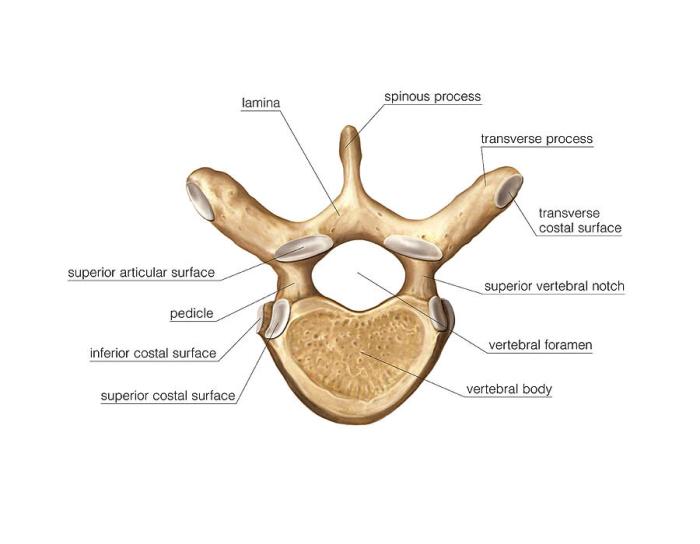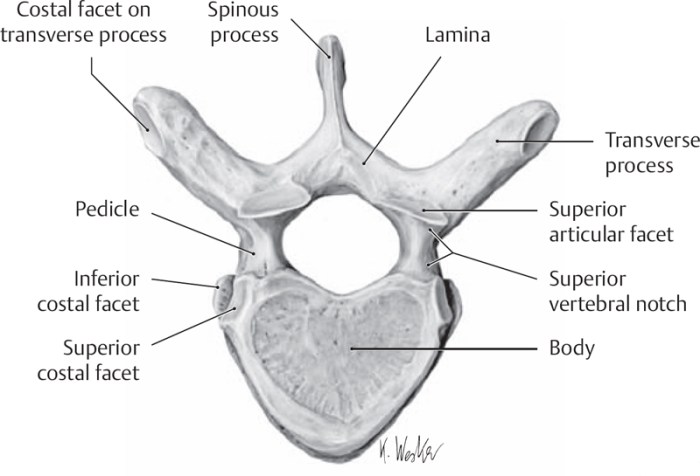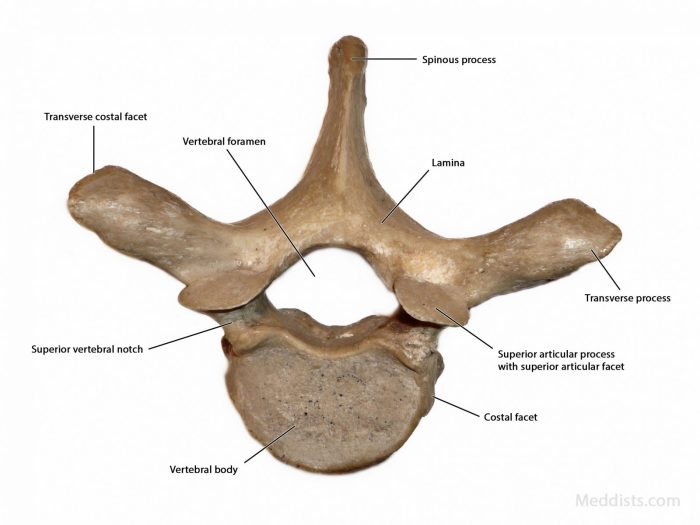Thoracic vertebrae labeled superior view provides a detailed and informative representation of the anatomy of the thoracic spine. This view allows for a thorough examination of the vertebral body, vertebral arch, transverse processes, articular processes, and vertebral canal, offering valuable insights into the structure and function of this crucial region of the spine.
The superior view of a thoracic vertebra reveals the vertebral body’s oval shape and anterior orientation. The presence of foramina and notches provides essential pathways for blood vessels and nerves, ensuring proper circulation and innervation. The vertebral arch, formed by the pedicles, laminae, and spinous process, protects the delicate spinal cord within the vertebral canal.
Thoracic Vertebrae: Labeled Superior View: Thoracic Vertebrae Labeled Superior View

Thoracic vertebrae are a group of 12 bones that make up the middle section of the spine. They are located between the cervical vertebrae (neck) and the lumbar vertebrae (lower back). Thoracic vertebrae are responsible for providing support to the rib cage and protecting the spinal cord.
Vertebrae Anatomy
A thoracic vertebra consists of a vertebral body, vertebral arch, transverse processes, and articular processes. The vertebral body is the large, cylindrical portion of the vertebra that forms the main structural support. The vertebral arch is a ring of bone that projects posteriorly from the vertebral body and encloses the vertebral canal, which houses the spinal cord.
The transverse processes are two lateral projections from the vertebral arch that provide attachment sites for muscles and ligaments. The articular processes are four projections from the vertebral arch that form facet joints with adjacent vertebrae, allowing for movement of the spine.
Vertebral Body
The vertebral body of a thoracic vertebra is heart-shaped in superior view. It is wider anteriorly than posteriorly and has a concave upper surface and a convex lower surface. The anterior surface of the vertebral body has a median crest that divides it into two halves.
The posterior surface of the vertebral body has two half-moon shaped articular facets for articulation with the heads of the ribs.
Vertebral Arch
The vertebral arch is formed by the pedicles, laminae, and spinous process. The pedicles are two short, thick columns of bone that extend posteriorly from the vertebral body and join the laminae. The laminae are two broad, flat plates of bone that form the roof of the vertebral arch and meet posteriorly to form the spinous process.
The spinous process is a triangular projection of bone that extends posteriorly from the junction of the laminae.
Transverse Processes
The transverse processes are two lateral projections from the vertebral arch that extend laterally from the junction of the pedicles and laminae. They are oriented slightly posteriorly and inferiorly. The transverse processes provide attachment sites for muscles and ligaments that stabilize the spine and facilitate movement.
Articular Processes
The articular processes are four projections from the vertebral arch that form facet joints with adjacent vertebrae. The superior articular processes are located on the superior aspect of the pedicles and face posteriorly and medially. The inferior articular processes are located on the inferior aspect of the pedicles and face anteriorly and laterally.
The facet joints formed by the articular processes allow for flexion, extension, and lateral bending of the spine.
Vertebral Canal, Thoracic vertebrae labeled superior view
The vertebral canal is a large, triangular opening enclosed by the vertebral arch. It extends through the center of the vertebra and houses the spinal cord. The vertebral canal is protected by the pedicles, laminae, and spinous process of the vertebral arch.
Variations and Clinical Significance
There are several variations in the anatomy of thoracic vertebrae. Some vertebrae may have additional foramina or notches for the passage of nerves or blood vessels. Some vertebrae may have bifid spinous processes or transverse processes. These variations are usually not clinically significant, but they can sometimes be associated with spinal disorders, such as spinal stenosis or nerve root impingement.
FAQ Corner
What is the significance of the vertebral foramen?
The vertebral foramen is a crucial opening within the vertebral arch that houses the spinal cord. It provides protection and facilitates the passage of nerves and blood vessels, ensuring proper functioning of the central nervous system.
How do the transverse processes contribute to spinal stability?
The transverse processes extend laterally from the vertebral arch and serve as attachment points for muscles and ligaments. These structures play a vital role in maintaining spinal stability, preventing excessive movement and providing support during various activities.

